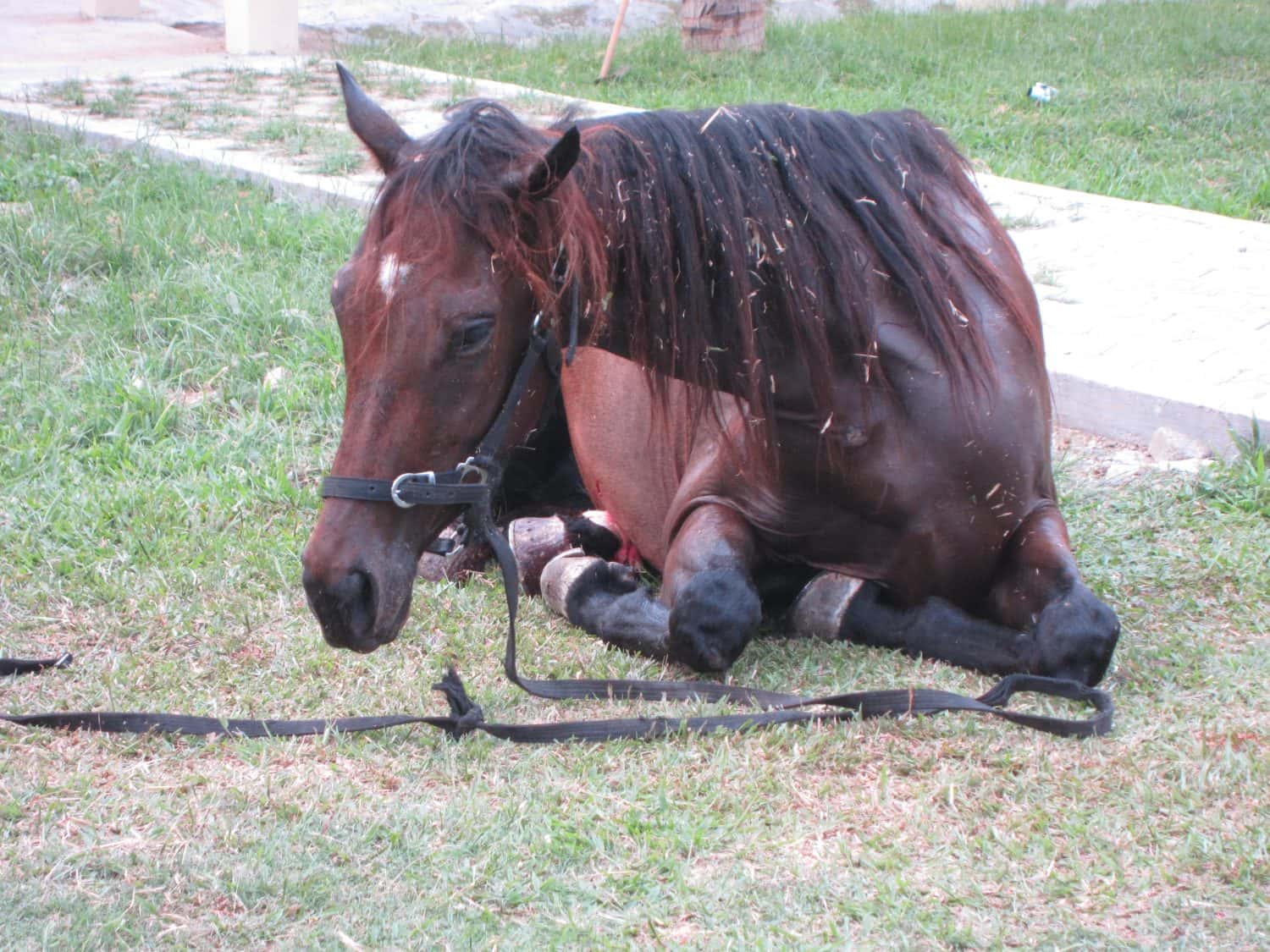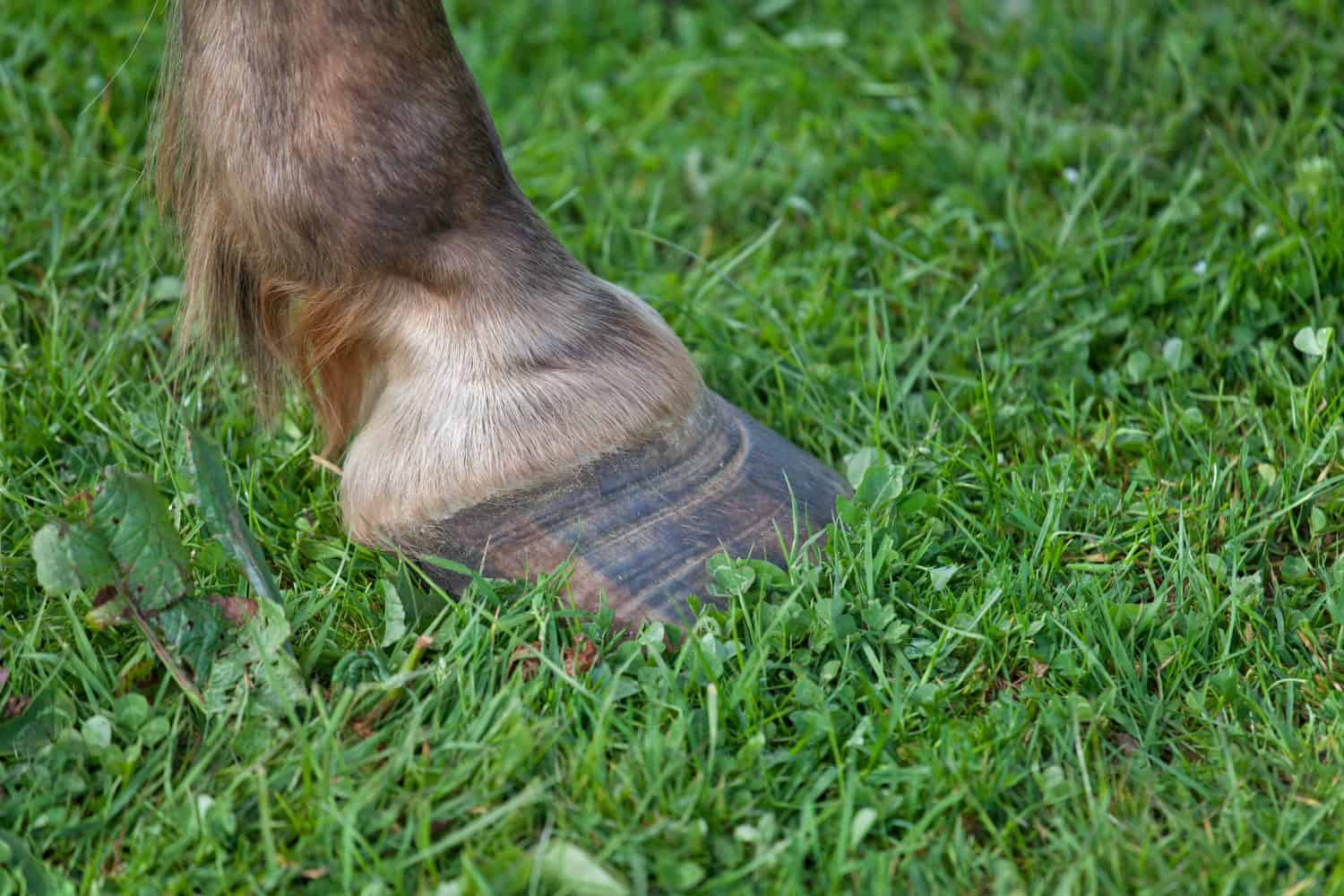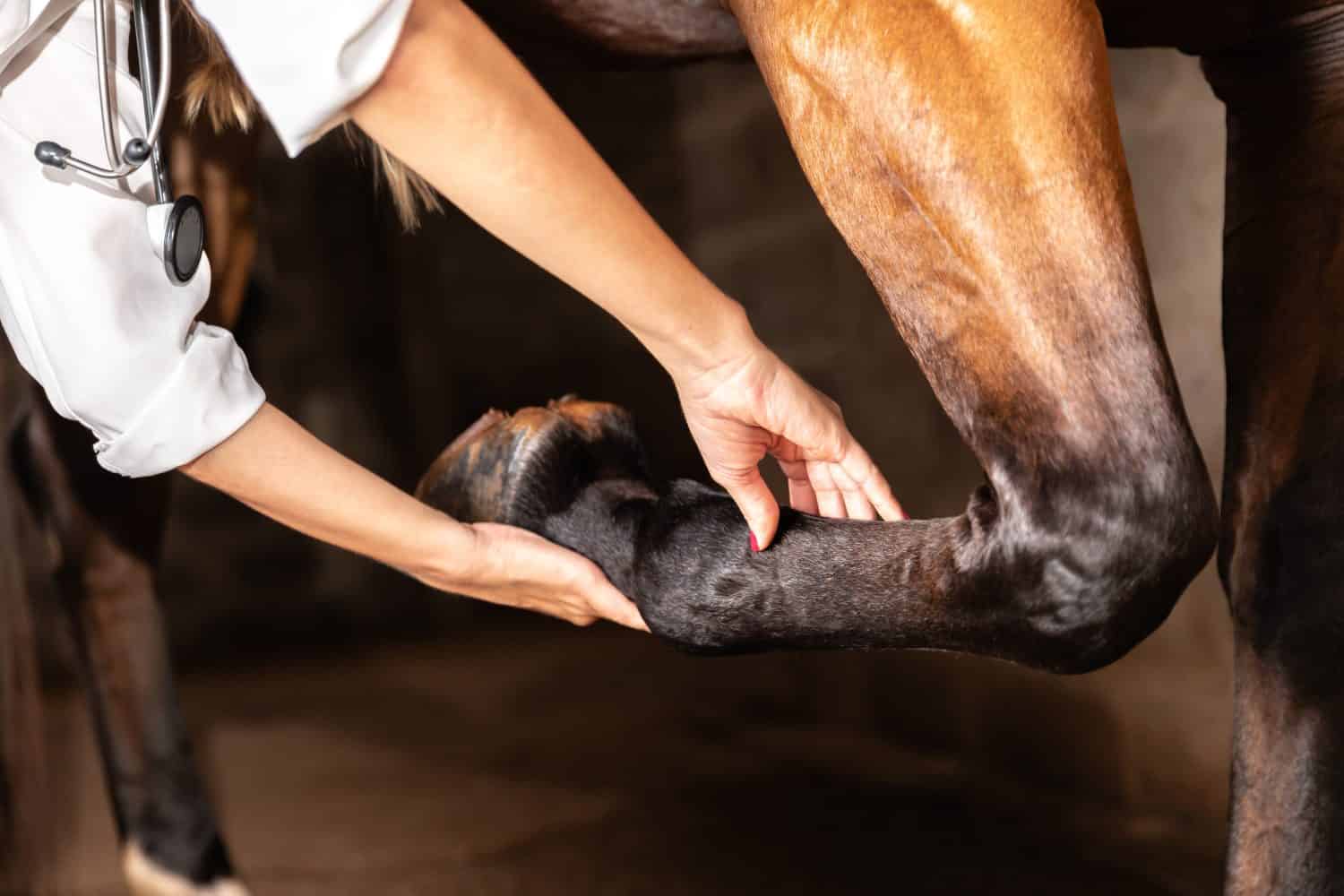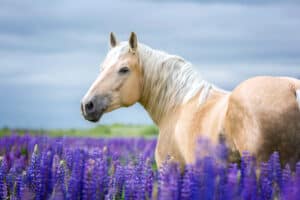Laminitis is a common, yet typically quite painful, and often reoccurring health issue affecting the hooves of equines. For horse caretakers, it’s crucial to learn the pathology of this condition. You’ll want to be able to recognize the red flags that your horse may be suffering from laminitis, understand prevention, and know common treatment interventions.
In this guide, we’ll cover laminitis in horses, what the causes are, the common signs and symptoms of this painful condition, and what treatment options are available.
Read on to learn more.
Laminitis in Horses: What is It?
Laminitis describes acute or chronic inflammation and damage of an equine’s laminae. The laminae are tissue layers that bind the inside of the hoof wall to the horse’s coffin (pedal) bone. This bone is encased by the hoof capsule. There are two types of interlocking laminae: the sensitive, or dermal, laminae, and the insensitive, or epidermal, laminae.
During laminitis, blood flow is disrupted to both the sensitive and insensitive laminae, causing cellular damage. As a result, laminitis weakens the bond between the hoof wall and the coffin bone. It may even cause the coffin bone to detach from the hoof wall, rotate, and sink toward the sole, causing extreme pain and lameness.
This condition most commonly affects the front feet concurrently, although it can also affect the back feet. If laminitis becomes chronic and severe enough to result in the detachment and rotation of the coffin bone from the hoof wall, the condition becomes known as “founder.” You may note that some people use the terms “laminitis” and “founder” interchangeably. However, founder or “foundering” denotes a specific severity and pathological status of this condition.
The severity of laminitis depends on the degree of damage to the laminae and how weakened the bone between the coffin bone and hoof wall bond is. It may range from mild discomfort to chronic episodes of gait changes and pain. In the worst case, it may develop into full-blown founder, resulting in extreme pain and lameness.
Three Stages of Laminitis in Horses
Three stages of laminitis exist: subclinical, acute, and chronic. This condition does not always progress from subclinical to chronic. Overall health, genetics, environmental conditions, treatments, underlying conditions, age, and preventative measures can all affect how laminitis presents or progresses in an individual.
Subclinical Laminitis
Subclinical laminitis presents as microscopic changes within the laminae. At this stage, cellular death of the connective tissue that attaches the dermal and epidermal laminae to each other can occur. Clinical and visible signs are not yet apparent.
Acute Laminitis
When clinical and visible signs of laminitis first present, the condition has progressed to acute laminitis. With acute laminitis, there is measurable inflammation of the dermal laminae. Most vets categorize acute laminitis as the first few days of the condition when observable clinical signs are present. At this stage, a varying degree of lameness, heat in the foot, and other signs are present. The condition may or may not, at this point, progress into chronic laminitis, although it often does.
Chronic Laminitis
Chronic laminitis occurs when the condition persists after the first few days of clinical symptoms. Many horses affected by chronic laminitis suffer from recurrent flare-ups. Clinical presentations can vary greatly depending on the severity of the condition. However, morphological changes of the laminae, and often the hoof, are present at this point. Severity can range from long-term, low-grade inflammation to a crippling, immensely painful condition. The most tragic cases can result in euthanasia being the most humane option for horses suffering from chronic severe pain and lameness.

Laminitis is a painful condition in which inflammation damages the laminae of the horse’s foot.
©Alimansyah Putra/Shutterstock.com
Laminitis in Horses: Causes
Unfortunately, equine caretakers must contend with a wide range of causes of laminitis. These causes are typically compartmentalized within the following three main categories:
- Endocrinopathic Laminitis
- Supporting Limb Laminitis
- Sepsis-Associated Laminitis
Endocrinopathic Laminitis
Endocrinopathic laminitis occurs in equines with an underlying endocrine disease. Vets and researchers are increasingly acknowledging underlying endocrine conditions as a major cause of laminitis in equines.
One such disorder is equine metabolic syndrome (EMS), a condition of the endocrine system characterized by insulin dysregulation, which is defined as abnormal glucose and fat metabolism. Affected horses typically struggle with obesity even when fed an appropriate diet. These individuals are at a greatly increased risk of laminitis. A 2023 study of 116 horses in Nigeria reported that 31.03% had laminitis, and out of those cases, 61.29% tested positive for equine metabolic syndrome.
Pituitary pars intermedia dysfunction (PPID), or equine Cushing’s disease, is a progressive, neurodegenerative, and endocrine disease that affects over 20% of senior horses, ponies, and donkeys. Many horses with this condition have insulin dysregulation, which results in a higher risk of laminitis for affected equines. In a 2022 study, researchers found that out of 325 horses with PPID, 32% had insulin dysregulation, and of those, 66% had laminitis.
Supporting Limb Laminitis
Supporting limb laminitis (SLL) occurs secondary to severe lameness in one of the horse’s limbs as a result of excessive weight bearing on the uninjured leg. For example, if a horse’s right front leg is injured to the extent that they can not bear weight on it, compensatory weight shifting onto the left front leg can result in supporting limb laminitis. Veterinary researchers estimate that between 10-27% of horses with non-weight-bearing lameness persisting over several weeks develop supporting limb laminitis on the non-injured leg. One common cause of SLL is the development of a hoof abscess that results in compensatory weight-bearing on the other foot.
Especially in cases of long-term non-weight bearing injuries, horses frequently develop severe laminitis and founder. The current understanding of SLL is that excessive, compensatory weight-bearing at rest causes damaging inflammation through decreased oxygen supply to the laminae. As opposed to the other main causes of laminitis, SLL typically only affects one leg.
Thoroughbreds are particularly at risk of developing SLL from a severe unilateral, non-weight-bearing injury. Horses that are unwilling or unable to put intermittent weight on the injured leg throughout the healing period are at a markedly increased risk of developing SLL.
Researchers have also observed that equines with poor hoof health and hooves characterized by long-toe, low-heel confirmation are also at an increased risk of developing SLL from a unilateral non-weight-bearing injury. Excessive foot trimming, improper shoeing, and excessive or intensive exercise on hard surfaces can also cause compensatory weight shifts at rest, resulting in SLL.
Sepsis-Associated Laminitis
In sepsis-associated laminitis, also known as systemic inflammatory response syndrome (SIRS)-associated laminitis, results secondary to a primary inflammatory condition. These conditions include colitis, ischemic intestinal injury, pneumonia, black walnut toxicity, and bacterial infection of the uterus (metritis). When sepsis-associated laminitis occurs, the horse’s immune system creates an overload of proinflammatory responses within the lamella that can lead to serious damage.
Additionally, excessive ingestion of carbohydrates or fructose can result in low pH in the hindgut. This low pH of the hindgut (acidosis) causes large populations of fiber-digesting gut bacteria to die and release cell-damaging toxins, causing an inflammatory response and resulting in laminitis.
Laminitis in Horses: Signs and Symptoms
Depending on the severity of laminitis in your horse, you may notice some or all of the following signs and symptoms:
- Visible lameness on one or more feet, especially on hard surfaces or when walking in a circle.
- A reluctance or inability to walk.
- Leaning back onto the hind feet (laminitic stance).
- Increase digital pulse in affected foot stemming from inflammation.
- A hoof that is consistently warmer than normal.
- Damage of foot sole.
- Change in the growth pattern of the white hoof rings.
- Reluctance or difficulty to get up after lying down.
- A protrusion of the sole indicates coffin bone rotation and sinking.
- Changes in the horse’s gait often present as taking shorter strides.
- Unequal rate of hoof growth resulting in the appearance of a dished hoof.

This pony’s hoof displays a low heel, long toe, and white laminitis rings.
©sharon kingston/Shutterstock.com
Laminitis in Horses: Treatments
All cases of laminitis should involve swift veterinary intervention and treatment plans. Since laminitis typically occurs secondary to an underlying condition, it’s crucial to thoroughly evaluate the horse for a range of possible illnesses and injuries. Depending on the case, your vet may utilize a range of interventions, including the following:
- Short or long-term anti-inflammatory and analgesic medication.
- Intravenous fluids.
- Mineral oil via a nasogastric tube in the case of GI upset.
- Antibiotics to fight an underlying infection in the case of sepsis-associated laminitis.
- Anticoagulants and vasodilators to improve blood flow to the feet.
- Draining and treating abscesses.
- Nutritional plans and long-term health management aimed at reducing flare-ups.
- Therapeutic hoof care and pasturing/stabling on softer ground.
- Avoidance of triggers such as pasturing in areas with high-sugar grass and reducing high-intensity exercise.

A range of analgesic, anti-inflammatory, nutritional, medicinal, and environmental interventions are available to help treat and manage equine laminitis.
©Brastock/Shutterstock.com
The photo featured at the top of this post is © 135pixels/Shutterstock.com
Thank you for reading! Have some feedback for us? Contact the AZ Animals editorial team.







